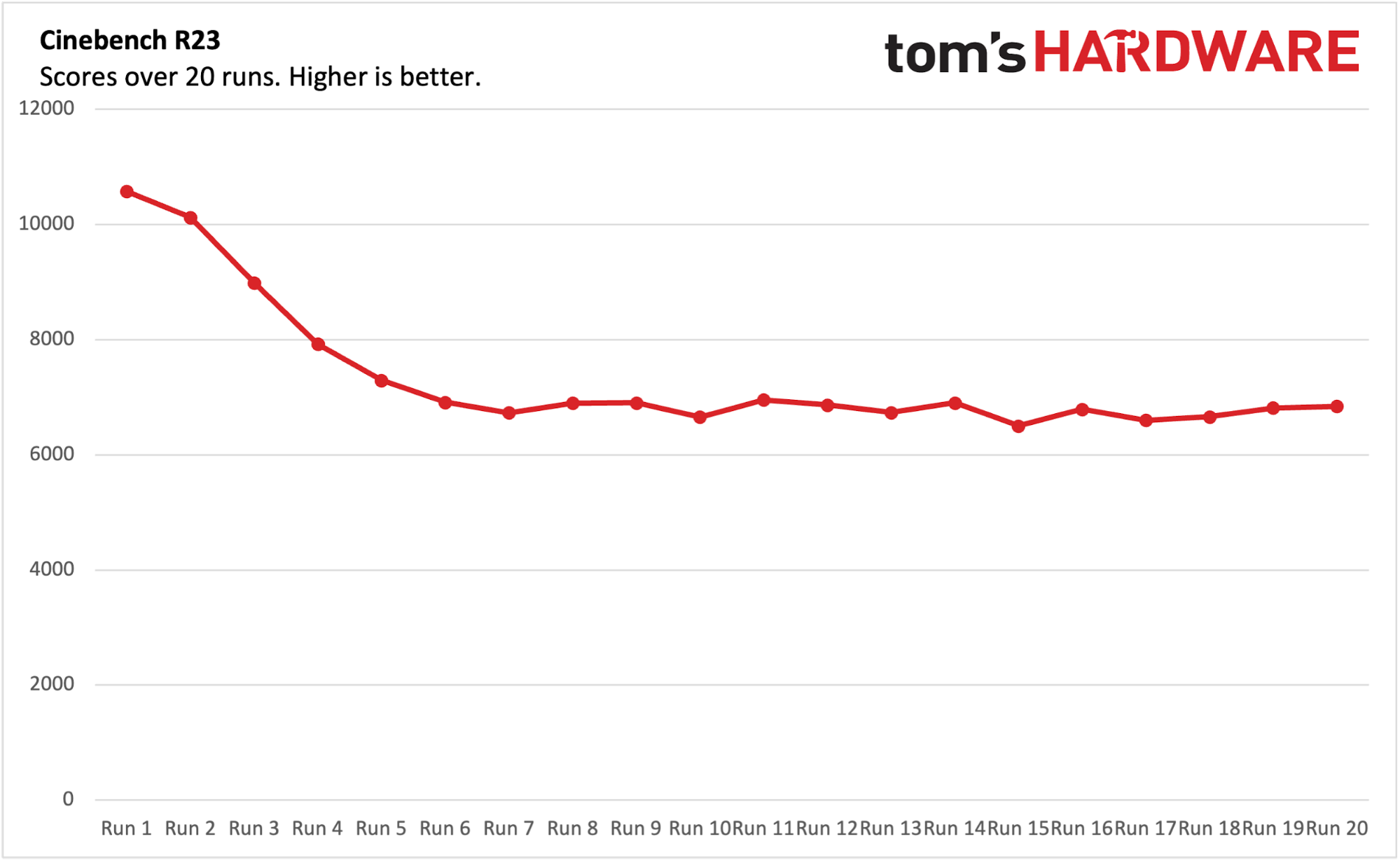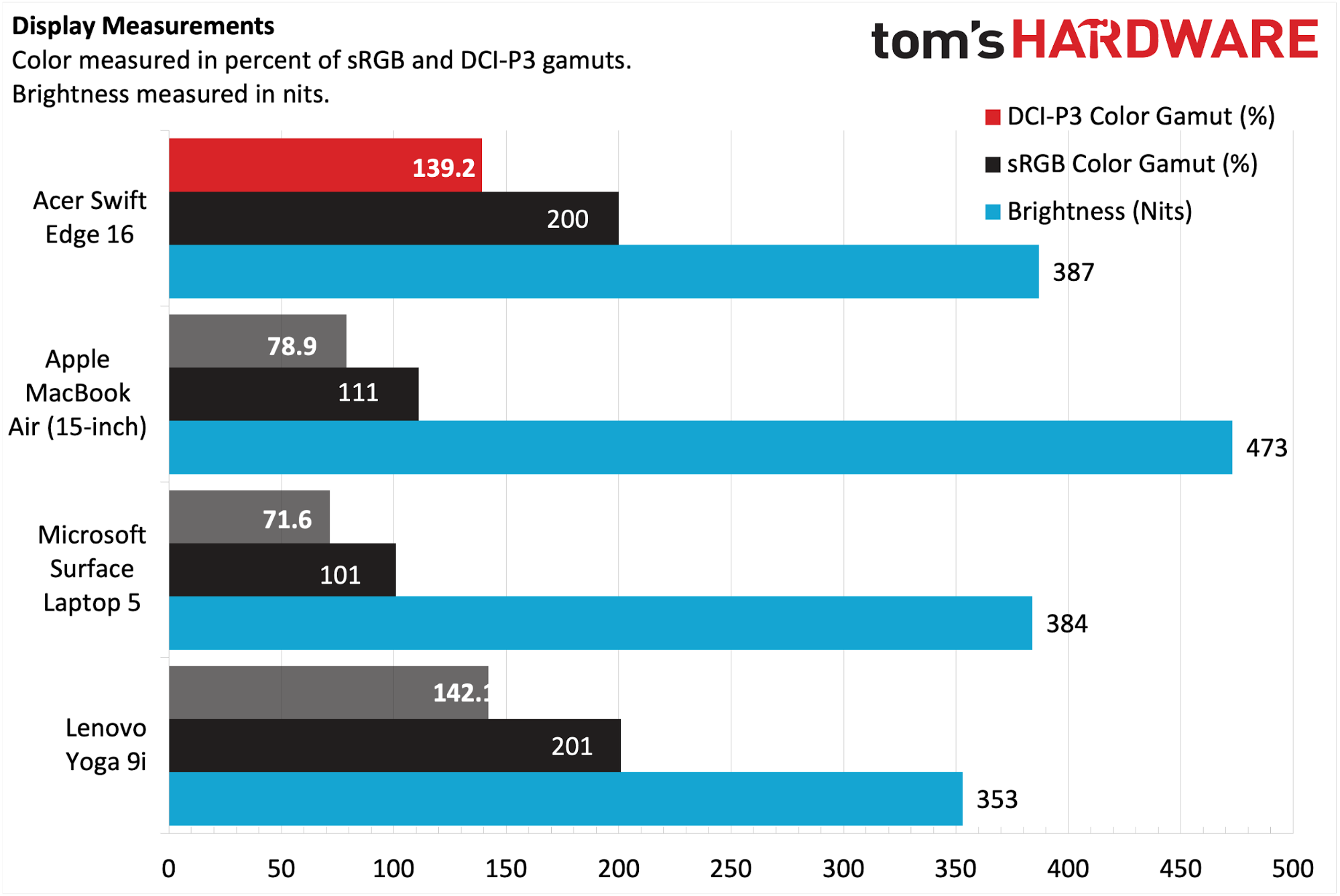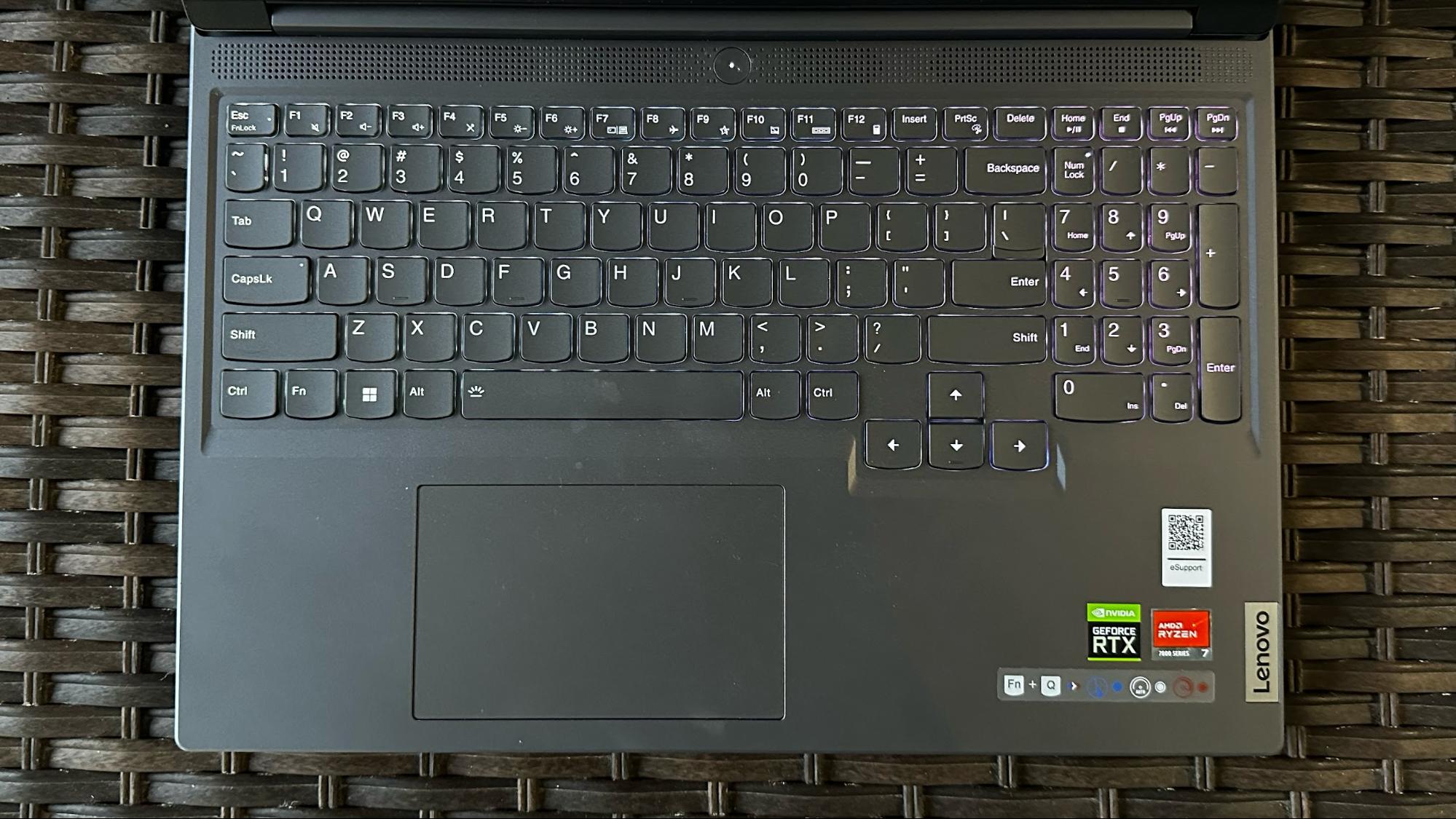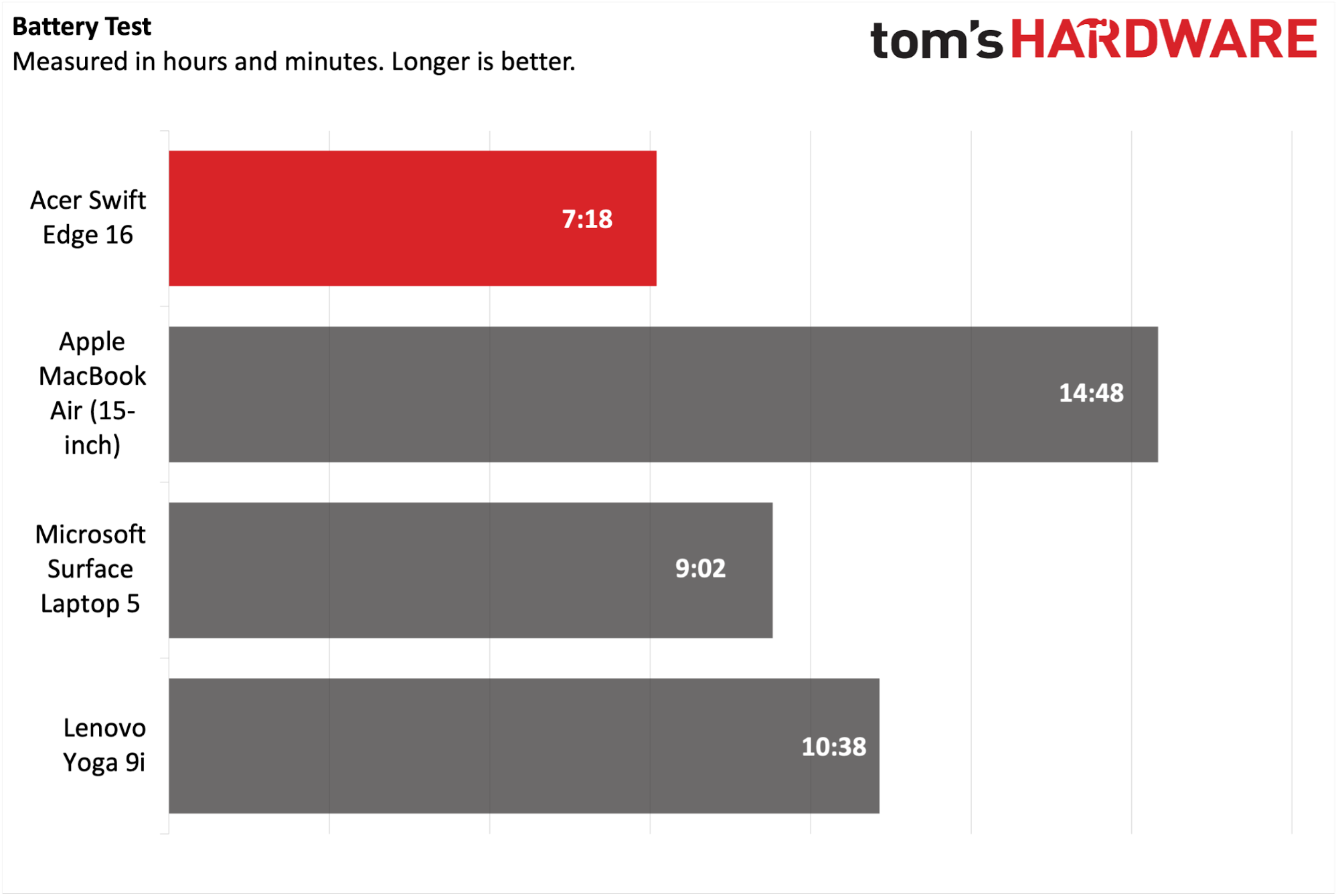Acer Swift Edge 16 Review: OLED Goodness in a Thin and Light Chassis
OLED displays are becoming more commonplace in the world of laptops. They promise richer and more saturated color and deliver inky blacks unmatched by other panel types offered on laptops. So, color me surprised when the Acer Swift Edge 16 made its way into the Tom’s Hardware lab, complete with a 16-inch OLED display with a price tag of less than $1,300.
However, it’s not just the display and price that impress; the Swift Edge 16 comes with a potent Ryzen 7 7840U processor, a comfortable keyboard with a number pad, the rare inclusion of a 1440p webcam along with a thin and lightweight chassis that makes it an easy travel companion when compared to the best ultrabooks and premium laptops.
Acer Swift Edge 16 Specifications
| CPU | AMD Ryzen 7 7840U |
| Graphics | AMD Radeon 780M Graphics (Integrated) |
| RAM | 16GB LPDDR5-6400 (non-upgradeable) |
| Storage | 1TB NVMe PCIe 4.0 x4 M.2 SSD |
| Display | 16-inch, OLED, 3200 x 2000, 120Hz |
| Networking | Wi-Fi 6E, Bluetooth 5.1 |
| Ports | 2x USB 4 Type-C, 2x USB 3.2 Gen 1 Type-A, 1x HDMI 2.1, 1x 3.5 mm jack, 1x micro SDXC slot |
| Camera | 1440p |
| Battery | 54 WHr |
| Power Adapter | 65W |
| Operating System | Windows 11 Home |
| Dimensions (WxDxH) | 14.08 x 9.68 x 0.60 inches (357.5 x 245.9 x 15.24 mm) |
| Weight | 2.73 pounds (1.24 kg) |
| Price (as Configured) | $1,299.99 |
Design of the Acer Swift Edge 16
“Sleek” and “thin” are the first two words that sprung to mind when I first took the Swift Edge 16 out of the box. The laptop is just 0.6 inches thick with the lid closed, allowing it to slip into a bag easily. That thinness is accompanied by a total weight of 2.73 pounds, which is roughly half a pound lighter than the 15-inch Apple MacBook Air.
However, that difference in weight between the two machines is exacerbated by the materials chosen by Apple and Acer, respectively. The former goes with an aluminum unibody that exudes quality and sturdiness. However, the latter uses a cheap, thin plastic upper chassis and an equally thin aluminum lower chassis cover. As a result, the chassis easily flexes and doesn’t elicit confidence in long-term durability.
I lightly pressed on the palm rest directly to the right of the touchpad and watched as the entire keyboard deck dipped down at least an eighth of an inch in response. The sub-3-pound weight is admirable, but it’s immediately apparent what sacrifices were made to achieve this figure.
The right side of the chassis is home to a USB 3.2 Gen 1 Type-A port, headphone jack and a microSD card slot. The opposite side gives you an additional USB 3.2 Gen 1 Type-A port, two USB4 Type-C ports and an HDMI 2.1 port. The Swift Edge 16 charges via one of the two USB-C ports using a 65-watt power adapter. Unlike competing USB-C chargers from Apple and Samsung, Acer’s power brick and USB-C cord are attached instead of being two separate pieces.
A full-size keyboard sits front and center, with a narrow number pad off to the side. A 3.4 x 5.1-inch touchpad sits off-center below the keyboard.
However, the star of the show is undoubtedly the 16-inch OLED display, surrounded by relatively thin bezels all around. This is a 120 Hz unit that is VESA DisplayHDR True Black 500 certified. Like many OLED panels, this one features a glossy coating, which is meant to improve the clarity of the picture. While that may be the case, the glossy finish was a magnet for reflections in my home office. Sitting above the display was another surprise, a 1440p webcam.
The Swift Edge 16 measures 14.08 x 9.68 x 0.60 inches, giving it a slightly larger footprint than the 15-inch MacBook Air. It’s also marginally larger dimensionally than the Lenovo Yoga 9i, a 3.09-pound, 14-inch convertible. The 15-inch Microsoft Surface Laptop 5 measures 13.4 x 9.6 x 0.58 inches and weighs 3.4 pounds.
Acer Swift Edge 16 Productivity Performance
The Swift Edge 16 uses an AMD Ryzen 7 7840U, an octa-core processor with a 3.3 GHz base clock and a 5.1GHz turbo clock. Acer configures the laptop with 16GB of LPDDR5 memory and a 1TB SSD.
Starting with the Geekbench synthetic CPU benchmark, the Swift Edge 16 virtually tied with the MacBook Air (M2, 16GB RAM) in the single-core benchmark (1,899). However, in the multi-core test (9,624), the Swift Edge 16 bested the MacBook Air and came in second to the Yoga 9i (Core i7-1360P, 16GB RAM), which scored 9,954.
In our file transfer test, which copies 25GB of files, the Swift Edge 16 hit 1,269.79 MBps. That was good enough for third place behind the MacBook Air (1,342.38 MBps) and the Yoga 9i (1,669.29 MBps). The Surface Laptop 5 (Core i7-1265U, 16GB RAM) wasn’t a contender, delivering just 532.52 MBps during the test.
The Swift Edge 16 took an easy win in our Handbrake test, which involves encoding a 4K video to 1080p. The laptop completed the task in just 7 minutes and 18 seconds, putting it 28 seconds ahead of the MacBook Air. The Yoga 9i was the laggard in this group, requiring 9:45 to finish.

In our Cinebench R23 stress test, we perform 20 runs and record the scores. The Swift Edge 16 started the test with a score of 10,575.95, declining significantly from there as heat ramped up. Scores leveled off in the 6,600 to 6,800 range after about seven runs. During the test, the Ryzen 7 7840U chugged along at 2.04GHz and 58.91 degrees Celsius (138.03 degrees Fahrenheit).
Display on the Acer Swift Edge 16
The Swift Edge 16 features an OLED display, which is a welcome inclusion in the sub-$1,500 price category. As the laptop’s name implies, the panel measures 16 inches across and has a 3,000 x 2,000 resolution (3:2 aspect ratio, which we’re used to seeing in Microsoft’s Surface family) and a 120Hz refresh rate. Acer claims that the panel is VESA DisplayHDR True Black 500 certified.
I found the display to be bright enough for typical use, but the glossy coating couldn’t shake the reflections I saw. Not only could I see my reflection staring back at me (particularly apparent with dark content) in my home office, but the effect was only exacerbated outside in the sunlight.

With that said, when the lighting was ideal, the rich colors and inky blacks of the OLED panel were a joy to behold. Although I went to see The Super Mario Bros. Movie in the theater, its recent digital release meant that I had to purchase the movie for my kids to watch over (and over, and over again). This was the perfect movie to showcase the Swift Edge 16’s display, with its rich color palette (particularly when Mario visits the Mushroom Kingdom). Likewise, Luigi’s descent into the bowels of the Dark Lands highlighted the excellent contrast.
Our instrumented testing confirmed what my eyeballs were seeing, with the Swift Edge 16 hitting 139.2 percent of DCI-P3 and 200 percent of sRGB (closely matching the performance of the OLED in the Yoga 9i). Brightness was also second only to the MacBook Air, coming in at 387 nits.
Keyboard and Touchpad on the Acer Swift Edge 16
The keyboard on the Swift Edge 16 felt good under my fingers, providing comfortable feedback with quiet operation. The feel of the keys reminds me of a close approximation to that of current-generation MacBook keyboards. Given the productivity-centric purpose of the laptop, there are no RGBs found here, although there is a soft white light that glows beneath the keys (and turns off after about 30 seconds to save power).

A narrow number pad, which is an increasingly common feature for 15- and 16-inch class laptops, is available for quick number entries. I appreciate its inclusion for making quick calculations and entering data into spreadsheets.
My go-to for typing tests is keyhero.com, and I managed to type at 85.03 words per minute with 97.91 percent accuracy. For comparison, I averaged 75 wpm and 90.61 percent accuracy on the similarly-sized Samsung Galaxy Book 3 Ultra using the same test, so I much preferred this keyboard.
Audio on the Acer Swift Edge 16
The Swift Edge 16 has two speakers, backed by Acer TrueHarmony technology. Acer claims that TrueHarmony provides more powerful, “headphone-like audio,” but that wasn’t my experience.
The audio was as lifeless as you’d expect with a laptop this thin and light. The speakers weren’t overly loud even with the volume cranked to 100 percent. With that said, they were distortion-free at this volume. I dialed the volume back to about 60 percent and played Guns N’ Roses’ “November Rain.” No matter the volume level, the audio sounded thin and hollow from the downward-firing speakers. OK, maybe it’s a tall order to expect perfection when reproducing audio from one of the greatest rock songs of the 1990s on a $1,300 laptop, especially one that is so svelte, but non-existent bass and no attention to the highs leaves much to be desired.
If you want to use the Swift Edge 16 to handle video calls or watch YouTube videos while doing other tasks, the speakers will suit you just fine. However, grab a pair of good headphones if you want to actually enjoy music.
Upgradeability of the Acer Swift Edge 16
The Swift Edge 16’s internals are accessible by removing six T6 screws on the bottom of the chassis. With the screws removed, I stuck my thumbnail near one of the USB ports and carefully pried off the panel.
Unfortunately, there’s not much to see once inside; the battery is replaceable, as is the M.2 SSD (although there is only one M.2 slot for storage). The Wi-Fi 6E/Bluetooth combo card is also replaceable if you so choose. The LPDDR5 memory is soldered onto the motherboard, so there are no provisions for upgrading your memory from the standard 16GB in the future. This is, unfortunately, increasingly common on thin PCs.
Battery Life on the Acer Swift Edge 16
Among its competitors the Swift Edge 16 wasn’t a standout in our endurance test (web browsing, light graphics work and video streaming while connected to Wi-Fi with Swift Edge 16’s display brightness set to 150 nits). It finished at the back of the pack (7:18).

The Surface Laptop 15 lasted nearly two hours longer, while the Yoga 7i gave up after 10 hours and 32 minutes. However, the MacBook Air was the endurance champion, lasting almost 15 hours on a charge.
Heat on the Acer Swift Edge 16
We take the skin temperature of ultrabooks while running the Cinebench R23 stress test to see how they deal with heat. During the test, the Swift Edge 16’s fans spun up noticeably to exhaust heat generated by the Ryzen 7 7840U. The aluminum bottom panel of the chassis was warm to the touch but was not uncomfortable to rest on my lap.
I measured 39.9 degrees Celsius (103.83 degrees Fahrenheit) between the G and H keys, while the touchpad was much cooler at 29.4 C (89.42 F). The bottom of the laptop saw the hottest temperatures, reaching 51.5 C (124.7 F) towards the left-rear corner.
Webcam on the Acer Swift Edge 16
With most new laptops coming out with 1080p webcams, it’s becoming harder to notice any significant differences between them. However, Acer is trying to one-up the competition with a 1440p webcam on the Swift Edge 16.
I didn’t expect a dramatic difference in quality compared to the 1080p competition, and my results confirmed that hypothesis. However, the details were incredibly crisp, the colors looked spot-on, and image noise was practically non-existent.
Acer doesn’t offer a physical privacy shutter for the webcam or a hotkey to deactivate it quickly. The webcam also isn’t Windows Hello compatible. You also won’t find other biometric security features like a fingerprint reader.
Software and Warranty on the Acer Swift Edge 16
Acer goes easy on the installed apps, as there isn’t much bloatware here. There’s an Acer product registration app, and the handy Acer Purified Voice Console allows you to configure microphone settings. Acer Care Settings monitors your system vitals (SSD, memory, battery health), performs system updates and can backup/restore your system – it’s a nice one-stop-shop for configuring the laptop. The only other preinstalled app from the factory is the venerable Realtek Audio Console.
Of course, you can expect to find the usual app shortcuts placed by default with each Windows 11 Home install, like Kindle, WhatsApp, and Spotify.
Acer provides a one-year manufacturer warranty with the Swift Edge 16.
Acer Swift Edge 16 Configurations
Our review unit features an AMD Ryzen 7 7840U processor, 16GB of RAM, a 1TB PCIe 4.0 SSD, and a 16-inch 3,200 x 2,000 OLED display. This model is exclusive to Best Buy and priced at $1,299. However, this configuration frequently goes on sale and was recently available at Best Buy for as low as $1,099. There’s also an older SKU with a 3840 x 2400 OLED display, Ryzen 7 7735U processor and a fingerprint reader for $1,299 (although it is often on sale at Costco for $899).
Bottom Line
The Acer Swift Edge 16 has a lot going for it. It’s lightweight and thin for this class, the 16-inch screen is gorgeous, and performance was strong across the board. Even better, the $1,299 price tag ($1,099 if you can grab it on sale) is quite compelling for a large-screen OLED laptop.
On the other hand, the speakers are subpar, the quality of the materials used (particularly the keyboard deck) could be better and battery life ranked at the bottom of the pack. The first issue is easily solved with a pair of headphones, while the second doesn’t feel as premium — or as durable — as other laptops in its class. As for endurance, seven hours of battery life is disappointing, especially compared to the 10-hour showing of the Lenovo Yoga 9i and the nearly 15-hour runtime of the 15-inch Apple MacBook Air.
The Yoga 9i is a fine alternative (if you like the convertible form factor and don’t mind the 14-inch display) due to its similar performance, sturdier construction, and longer battery life. The laptop also regularly goes on sale for $1,149, making it an even more compelling choice. The Swift Edge 16 still has a lot to offer, but perhaps a future update can address our battery life and durability concerns.
MORE: How to Buy a Gaming Laptop
MORE: Best Gaming PCs
MORE: Best Ultrabooks and Premium Laptops















